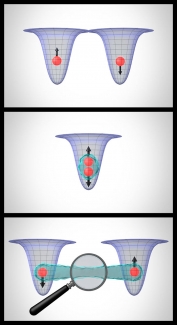The Regal and Rey groups have come up with a novel way to generate and propagate quantum entanglement [1], a key feature required for quantum computing. Quantum computing requires that bits of information called qubits be moved from one location to another, be available to interact in prescribed ways, and then be isolated for storage or subsequent interactions. The group showed that single neutral atoms carried in tiny traps called optical tweezers may be a promising technology for the job!
To prove this, the group prepared two ultracold neutral atoms of rubidium, then moved them until they were on top of one another. This positioning caused the spins of the atoms to become entangled after a bit of time. The group then separated the atoms while preserving their entanglement. The researchers were able to prove the enduring entanglement via measurements of the spin states of the separated atoms: When one of the atoms was spin up, the other was always spin down. However, the direction each spin fluctuated from one experiment to the next.
This exciting work was reported online in Nature on November 2, 2015. The researchers responsible for it included recently minted Ph.D. Adam Kaufman, graduate student Brian Lester, research associate Michael Wall, Fellows Ana Maria Rey and Cindy Regal, and former JILAn Michael Foss-Feig of the Joint Quantum Institute.
One of the most interesting parts of this work was that just moving two almost-identical atoms in different spin states on top of one another was sufficient to cause them to become entangled. When atoms (which exist as waves in the quantum world) get this close together, their waves overlap. As the atom waves “talk” to each other, they discover neither one of them is staying in one of their natural spin states, which they are normally happy to remain in indefinitely. Both atoms start flipping back and forth between spin up and spin down. It’s impossible to know which atom is spin up and which one is spin down at any give moment. Thus, the probability of measuring a particular configuration oscillates in time. This process leads to entanglement at certain times.
“All you have to do is place the atoms on top of one another, and they evolve into the state we want,” explained Regal. “You could say it occurs naturally.” In fact, the process used by the researchers happens in real materials with identical electrons.
And, if the researchers then separated the atoms, the atoms stayed entangled.
“In principle, the atoms could move half way around the world from each other and stay entangled, but we just pulled them apart a little ways in the lab,” Regal said. She noted that being able to prepare and entangle the two atoms and then separate them while retaining their entanglement are important capabilities for building a quantum computer.
Understanding how entanglement works is not only important for the future of quantum computing. It also has much to teach us about how quantum particles could form inside liquids and solids in which millions and millions of atoms co-exist on top of and up against each other. As a result, the natural entanglement observed in this work may help scientists better understand the similarities between these two seemingly very different processes.––Julie Phillips
[1] When two atoms are entangled, it means the behavior of one atom is correlated with the other.




